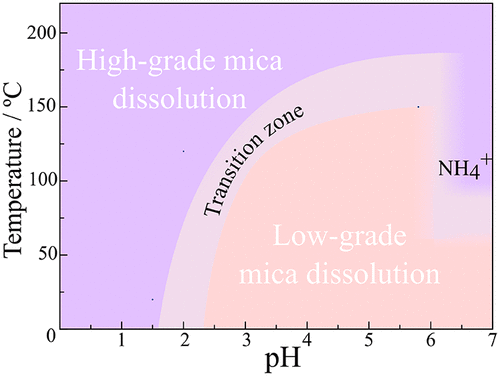当前位置:
X-MOL 学术
›
ACS Earth Space Chem.
›
论文详情
Our official English website, www.x-mol.net, welcomes your
feedback! (Note: you will need to create a separate account there.)
The Role of pH, Temperature, and NH4+ during Mica Weathering
ACS Earth and Space Chemistry ( IF 2.9 ) Pub Date : 2019-11-04 , DOI: 10.1021/acsearthspacechem.9b00219 Daniel Lamarca-Irisarri 1 , Alexander E. S. Van Driessche 2 , Guntram Jordan 3 , Chiara Cappelli 1, 4 , F. Javier Huertas 1
ACS Earth and Space Chemistry ( IF 2.9 ) Pub Date : 2019-11-04 , DOI: 10.1021/acsearthspacechem.9b00219 Daniel Lamarca-Irisarri 1 , Alexander E. S. Van Driessche 2 , Guntram Jordan 3 , Chiara Cappelli 1, 4 , F. Javier Huertas 1
Affiliation

|
Phyllosilicates are abundant materials both on Earth and Mars, and the weathering of these minerals is an essential part of a wide variety of geochemical cycles. Alteration mainly takes place at the solution–mineral interface and needs to be fully understood in order to correctly model global water–rock interactions. To directly link the physicochemical solution properties to the dominant surface processes controlling phyllosilicate alteration, we used a custom-built hydrothermal atomic force microscope to study in situ the surface reactivity of biotite, phlogopite, and muscovite in contact with aqueous solutions for a broad range of temperatures and pH values. On the basis of our microscopic observations correlated with previously obtained macroscopic dissolution rates, we have constructed a tentative weathering diagram for mica minerals connecting the dominant surface mechanisms and bulk dissolution behavior to the physicochemical solution properties (pH, T, and speciation). The resulting diagram can be divided into two main areas: low-grade weathering occurring at low temperatures and mildly acidic to neutral pH and high-grade weathering taking place at high temperatures and low pH, separated by a transition zone. Each of these areas is characterized by a series of chemical and physical surface processes, which can be related directly or indirectly to incongruent and congruent bulk dissolution. The transition temperatures and pH values depend on the type of mica, with biotite being the most reactive one and muscovite the least reactive one. It is noteworthy that for close to neutral pH conditions the presence of NH4+ shifts the transitions from low- to high-grade weathering to a significantly lower temperature.
中文翻译:

pH,温度和NH 4 +在云母风化中的作用
苯硅酸盐是地球和火星上的丰富物质,这些矿物的风化作用是多种地球化学循环的重要组成部分。变更主要发生在溶液-矿物界面,并且需要完全理解以正确建模全球水-岩相互作用。为了直接将理化溶液的特性与控制页硅酸盐蚀变的主要表面过程联系起来,我们使用了定制的水热原子力显微镜来研究黑云母,金云母和白云母与水溶液接触的表面反应性,研究范围广泛。温度和pH值。根据我们与先前获得的宏观溶出度相关的微观观察结果,T和物种)。生成的图可分为两个主要区域:低温下发生的低级风化和中性至中性pH的弱酸性;高温下和低pH下的高等级风化,由过渡区隔开。这些区域中的每个区域都具有一系列化学和物理表面过程,这些过程可以直接或间接与不一致和一致的整体溶解相关。转变温度和pH值取决于云母的类型,其中黑云母是反应性最高的一种,白云母是反应性最低的一种。值得注意的是,在接近中性pH的条件下,NH 4 +的存在将其转变从低度风化转变为高度风化。
更新日期:2019-11-04
中文翻译:

pH,温度和NH 4 +在云母风化中的作用
苯硅酸盐是地球和火星上的丰富物质,这些矿物的风化作用是多种地球化学循环的重要组成部分。变更主要发生在溶液-矿物界面,并且需要完全理解以正确建模全球水-岩相互作用。为了直接将理化溶液的特性与控制页硅酸盐蚀变的主要表面过程联系起来,我们使用了定制的水热原子力显微镜来研究黑云母,金云母和白云母与水溶液接触的表面反应性,研究范围广泛。温度和pH值。根据我们与先前获得的宏观溶出度相关的微观观察结果,T和物种)。生成的图可分为两个主要区域:低温下发生的低级风化和中性至中性pH的弱酸性;高温下和低pH下的高等级风化,由过渡区隔开。这些区域中的每个区域都具有一系列化学和物理表面过程,这些过程可以直接或间接与不一致和一致的整体溶解相关。转变温度和pH值取决于云母的类型,其中黑云母是反应性最高的一种,白云母是反应性最低的一种。值得注意的是,在接近中性pH的条件下,NH 4 +的存在将其转变从低度风化转变为高度风化。











































 京公网安备 11010802027423号
京公网安备 11010802027423号